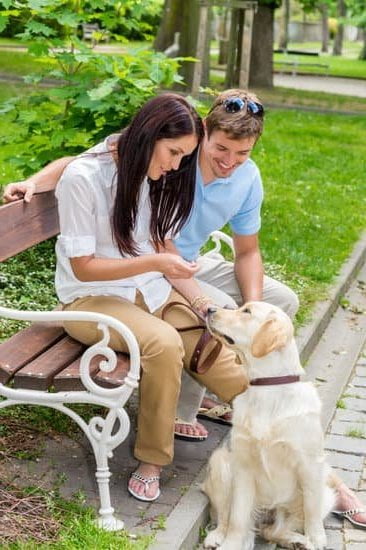Introducing a dog into a household with cats can be a daunting task. The unique differences in behavior and communication between these two species often present challenges that require careful training and management. However, with the right techniques and consistent effort, it is possible to achieve harmony between dogs and cats in the same living space.
In this article, we will explore the dynamics between dogs and cats, highlighting both the common challenges that arise when introducing them and the potential benefits of successful coexistence. We will provide practical tips on assessing your dog’s temperament and creating a safe environment for training. Additionally, we will discuss step-by-step methods for introducing scents, setting up controlled introductions, and implementing reward-based training techniques.
Understanding how dogs and cats communicate and interact is crucial in ensuring a smooth transition. By following the advice provided in this article, you can increase your chances of successfully training your dog to live harmoniously with cats.
Whether you are embarking on this journey for the first time or looking for additional guidance to improve an existing relationship between your pets, this article aims to equip you with valuable knowledge and strategies for achieving a peaceful pet coexistence. Stay tuned as we delve into each aspect of this fascinating dynamic.
Assessing Your Dog’s Temperament and Preparing for Training
Before attempting to train your dog to live with cats, it is crucial to assess your dog’s temperament and determine if they are a good fit for coexisting with felines. Each individual dog has unique personality traits that may affect their compatibility with cats. It is important to understand these traits in order to set realistic expectations and ensure the safety and well-being of both pets.
Identifying Your Dog’s Personality Traits
One of the first steps in assessing your dog’s temperament is to consider their prey drive. Some dogs have a strong instinctive desire to chase or hunt small animals, which can make them less suitable for living with cats.
Breeds such as terriers or sight hounds, which were originally bred for hunting, tend to have a higher prey drive. On the other hand, there are breeds that have been historically bred for herding or guarding livestock, making them more inclined to get along with other animals.
Observing how your dog reacts when encountering smaller animals outside can give you an idea of their prey drive. Keep in mind that even if your dog shows no interest in squirrels or birds, it does not necessarily mean they will automatically get along with cats. Additionally, considering factors like your dog’s age, past experiences with cats (if any), and overall level of obedience can also provide insights into their compatibility.
Tips for Creating a Calm and Safe Environment
Prior to introducing your dog and cat, it is essential to create a calm and safe environment for both pets. This will help minimize potential stress and prevent any negative associations from forming between them.
Start by ensuring that each pet has their own secure space within the home where they can retreat when needed. This space should be equipped with comfortable bedding, toys, food, water, and litter boxes (for cats). Introduce your dog to their designated area and establish clear boundaries using baby gates or closed doors. This will help provide your cat with a safe space while allowing your dog to become familiar with their scent.
Additionally, it is important to address any existing behavioral issues of your dog before attempting to introduce them to cats. If your dog displays signs of aggression or has difficulty following basic commands, seek the guidance of a professional trainer or behaviorist. By addressing these concerns beforehand, you can create a safer and more harmonious environment for both pets during the training process.
Introducing Scents
When it comes to introducing a dog and a cat, one of the first steps in creating a harmonious environment is familiarizing your dog with the scent of the cat. This process helps your dog become accustomed to the presence of a new animal in their territory and can pave the way for a smoother introduction.
The Importance of Scent Exchange
Scent exchange plays a crucial role in helping your dog and cat become acquainted before they even meet face-to-face. Dogs rely heavily on their sense of smell, so by exposing them to the scent of the cat, they can gradually adjust to their presence without feeling threatened or alarmed. This initial exposure can create positive associations and reduce potential stress during future interactions.
One effective way to initiate scent exchange is by swapping bedding between the two animals. This allows them to become familiar with each other’s scents in a low-pressure environment. Another option is utilizing pheromone products specifically designed for this purpose. These products mimic natural chemical signals emitted by cats, which can help ease any anxiety or tension your dog may feel.
Techniques for Facilitating Familiarity
In addition to scent swapping, there are other techniques you can employ to facilitate familiarity between your dog and cat. For instance, you can introduce toys or objects that have been in contact with each pet’s scent into each other’s living spaces. This allows both animals to associate positive experiences with each other’s smells.
It’s important to note that some dogs may be more sensitive or reactive than others when exposed to new scents. If you notice signs of stress or discomfort during this process, consult with a professional trainer or behaviorist for guidance on how to proceed safely and at a pace that suits your individual pets’ needs.
By taking these initial steps to introduce scents gradually, you lay the foundation for a smoother introduction between your dog and cat. Remember to remain patient and observant throughout the process, as every animal is unique and may require different amounts of time to adjust.
Setting up the Perfect Introduction
Introducing a dog and a cat requires careful planning and a gradual process to ensure their safety and well-being. Rushing the introduction can lead to stress, fear, and potential conflicts between the two animals. By following a step-by-step guide, you can set up the perfect introduction and increase the chances of a positive outcome.
The first step in setting up the perfect introduction is to choose a controlled environment where both animals can meet safely. It’s important to choose a neutral space that neither pet considers their territory. This can help reduce any territorial aggression that may arise during initial interactions. It’s also recommended to keep both pets on leashes or behind baby gates initially to maintain control over their movements.
During the first meeting, it’s crucial to observe their behavior closely for any signs of fear, aggression, or discomfort. If either animal displays fear or aggressive behavior, it’s best to separate them and try again later with shorter periods of supervised interaction. Over time, as they become more comfortable with each other’s presence, you can gradually increase their exposure and supervised time together.
It’s important to note that each dog and cat will have its own unique personality and temperament. Some dogs may be more prone to predatory behavior towards cats, while others may be naturally more friendly and curious. Adjusting the pace of introductions based on your individual pets’ comfort levels is essential for success.
| Key Steps | Description |
|---|---|
| Choose a Controlled Environment | Select a neutral space where both animals feel safe |
| Observe Behavior Closely | Monitor for signs of fear, aggression, or discomfort |
| Adjust the Pace | Gradually increase exposure and supervised time together based on comfort levels |
By following these steps and taking into consideration the individual personalities of your pets, you can facilitate a smoother and safer introduction process. With patience and proper management, you can increase the likelihood of a harmonious bond between your dog and cat.
Reward-Based Training
Reward-based training is a crucial aspect of successfully training dogs and cats to live together harmoniously. By utilizing positive reinforcement techniques, you can shape your dog’s behavior and help them develop positive associations with cats. Treats, praise, and clicker training are effective tools in establishing new habits and encouraging your dog to display appropriate behavior around cats.
The first step in reward-based training is to identify the desired behavior you want your dog to exhibit around cats. This could include calmness, ignoring or being gentle with the cat, or responding to commands when in the presence of a cat. Once you have identified these behaviors, you can use rewards to reinforce them.
Treats are often the most popular reward used in training dogs. When your dog displays the desired behavior around the cat, such as being calm or ignoring the feline, immediately reward them with a treat. This positive reinforcement helps your dog associate their good behavior with something pleasurable.
In addition to treats, praise is another powerful tool for rewarding your dog during training sessions. Verbal praise, such as saying “good job” or “well done,” can be combined with physical affection like petting or belly rubs. The combination of positive words and physical touch reinforces the message that their behavior is desirable.
Clicker training is also an effective technique for shaping positive associations between dogs and cats. A clicker is a small handheld device that makes a distinct clicking sound when pressed. The sound of the clicker marks the desired behavior in real-time, signaling to your dog that they have performed correctly. Immediately after clicking, offer a treat as a reinforcement reward.
It’s important to note that consistency is key when using reward-based training methods. Reinforce positive behaviors consistently every time they occur and avoid inadvertently rewarding undesirable behaviors. With patience and consistency, you can shape your dog’s behavior through reward-based training and foster a peaceful coexistence between dogs and cats.
| Training Method | Description |
|---|---|
| Treats | Using food rewards to reinforce desired behaviors in dogs |
| Praise | Verbal acknowledgment and physical affection to reward good behavior |
| Clicker Training | Using a clicker to mark desirable behavior, followed by a treat as reinforcement |
Creating a Safe Space
When introducing dogs and cats, it is crucial to provide separate zones for each pet within your home. This ensures that both animals have a safe space they can retreat to when they need personal time or want to be away from the other. Having designated areas also helps prevent potential conflicts and reduces stress for both the dog and cat.
Here are some tips for creating separate zones for dogs and cats:
- Establish Cat-Only Zones: Set up areas in your home where your cat can feel secure and comfortable without the presence of the dog. This could be a specific room or even part of a room that is gated off. Make sure this area has all the necessary essentials for your cat, such as food, water, litter box, scratching posts, toys, and a cozy bed.
- Create Dog-Free Havens: Similarly, create spaces in your home that are inaccessible to the dog. This could be a higher shelf or perch where the cat can observe from above or another room that is off-limits to the dog. These spaces should provide the cat with vertical territory as well as hiding spots if needed.
- Use Visual Barriers: If creating completely separate zones is not possible in your living situation, you can use visual barriers to help create boundaries. Baby gates or pet doors with flaps can be installed to maintain physical separation while still allowing some interaction between the dog and cat.
Remember that it may take some time for both pets to adjust to their separate zones. Be patient and allow them to explore their respective spaces at their own pace. Gradually increase their exposure to each other over time while always ensuring they have a safe space to retreat if needed.
By providing separate zones for dogs and cats, you are promoting their overall well-being and comfort within your home. These designated areas will help minimize stress and increase harmony between the two species, creating a more peaceful coexistence for everyone involved.
Managing Interspecies Conflicts
Introducing a new dog into a household with cats can sometimes lead to conflicts and potential aggression between the two species. It is important to handle these situations carefully and take steps to ensure the safety and well-being of both pets. Here are some strategies for addressing aggression or predatory instincts displayed by your dog towards cats:
- Understanding the Root Causes: Aggression in dogs towards cats can stem from various factors, including fear, resource guarding, or a prey drive. Identifying the underlying cause of your dog’s aggressive behavior is crucial in effectively managing the situation.
- Gradual Introduction and Supervision: When introducing your dog to cats, it is essential to do so in a controlled environment under close supervision. Begin with short periods of supervised interaction and gradually increase the time as they become more comfortable with each other.
- Training and Positive Reinforcement: Implementing reward-based training techniques can help shape positive behaviors in dogs around cats. Use treats, praise, and clicker training as effective tools to establish new habits and reinforce appropriate behavior when they are calm and non-aggressive towards the cat.
- Separation and Gradual Familiarity: If your dog displays aggressive behavior towards cats, it may be necessary to create separate areas for each pet within your home. This allows them to have their own space where they feel safe while gradually becoming familiar with one another’s presence through scent exchange activities such as swapping bedding or using pheromone products.
- Seek Professional Help if Needed: If your dog’s aggression towards cats persists despite your efforts, it may be beneficial to seek guidance from a professional animal behaviorist or trainer who specializes in inter-pet relationships. They can provide personalized advice based on the specific situation and help you address any severe behavior issues effectively.
Remember that every pet is unique, and it may take time for them to adjust and develop a harmonious relationship. Patience, consistency in training, and ensuring both pets feel safe are key factors in managing interspecies conflicts successfully. By following these strategies and seeking professional help if needed, you can work towards achieving a peaceful coexistence between your dog and cat.
Continuing Education
Once you have successfully introduced your dog and cat and they are starting to coexist peacefully, it is important to remember that training and supervision should continue throughout their lives. Ongoing training and supervision are essential to maintain a harmonious relationship between your dog and cat.
Consistency in training is key when it comes to reinforcing positive behaviors. Keep practicing the commands and cues you have taught your dog, such as “leave it” or “stay,” especially when your cat is around. Reward your dog with treats, praise, or playtime whenever they show calm behavior or respond appropriately to your commands. This will help them associate positive experiences with the presence of the cat.
Supervision is crucial in preventing potential conflicts from arising. Even if your dog has shown no signs of aggression towards the cat in the past, it is always better to be safe than sorry. When you cannot directly supervise their interactions, keep them separated by using baby gates or separate rooms.
Consider investing in monitoring tools such as cameras or pet-specific motion sensors that can alert you if any questionable behavior occurs while you are away. This can provide peace of mind knowing that you can intervene if necessary.
Remember that every dog-cat relationship is unique, and some dogs may require more ongoing training and supervision than others. Pay close attention to their interactions and behavior, being prepared to adjust your approach if needed.
By providing ongoing education for both your dog and cat and maintaining constant supervision, you can ensure a peaceful coexistence between these two beloved pets in your household. Continued efforts will strengthen their bond over time while creating a safe environment for both of them to thrive together.
Success Stories
One of the most powerful motivators when it comes to training a dog to live harmoniously with cats is hearing success stories from other pet owners who have accomplished this feat. Real-life examples not only provide inspiration, but they also offer valuable insights into what strategies and techniques worked for others in similar situations. These success stories serve as proof that dogs and cats can indeed coexist peacefully under the same roof.
One such success story involves Sarah, a Labrador Retriever, and her owner Lisa, who already had two cats in their home. At first, Sarah’s enthusiasm towards the cats was overwhelming, which led to initial challenges in their introduction. However, Lisa remained patient and followed a gradual approach. She started by using scent exchange techniques, allowing Sarah to familiarize herself with the cat’s presence before any direct contact was made.
Over time, Lisa progressed to supervised introductions in controlled environments. Key aspects of this successful integration were managing Sarah’s behavior through reward-based training and providing safe spaces for both pets where they could retreat when needed. Through consistency, positive reinforcement, and continuous supervision, Sarah eventually learned appropriate behavior around the cats, leading to a peaceful coexistence between these once seemingly incompatible species.
Another inspiring success story is that of Mike and his Border Collie named Max. Mike adopted Max as a puppy and was determined to ensure a positive relationship between Max and his resident cat named Whiskers. Mike diligently followed proper introduction processes, starting with scent exchanges to familiarize Max with Whisker’s scent before any face-to-face interactions occurred.
With patience and consistent reward-based training sessions, Max learned to display calm behavior around Whiskers. This involved using treats and praise as rewards for appropriate behavior and redirecting any signs of prey drive or aggression towards positive outlets like interactive play or mental stimulation activities. Today, Max and Whisker are inseparable companions who enjoy each other’s company both indoors and outdoors.
These success stories are just a glimpse of what can be accomplished when commitment, patience, and proper training techniques are applied to the process of introducing dogs and cats. By learning from these real-life examples, dog owners can gain valuable insights into how to create a harmonious environment for their furry family members. With the right approach, it is possible for dogs and cats to not only live together but also develop deep bonds of friendship and companionship.
Conclusion
In conclusion, achieving a peaceful coexistence between dogs and cats is not only possible but highly rewarding. It requires patience, effort, and a commitment to training, but the end result is a harmonious household where both pets can thrive. By understanding the dynamics between dogs and cats, assessing your dog’s temperament, and following a step-by-step introduction process, you can set the foundation for a successful relationship.
Remember that scent exchange is an essential first step in familiarizing your dog with the cat’s presence. This can be done through swapping bedding or using pheromone products. Gradual introductions in a controlled environment are key to managing their initial interactions and ensuring their safety. Reward-based training techniques, such as positive reinforcement and clicker training, will help shape positive associations between your dog and cat.
It’s important to provide separate zones for dogs and cats within your home to allow them personal space when needed. Managing any potential conflicts or aggression requires strategies catered to each specific situation, and seeking professional help if necessary is always an option. Ongoing training and supervision are crucial to maintaining the harmony achieved between your dog and cat.
Lastly, success stories of dogs living peacefully with cats serve as inspiration for all pet owners on this journey. These stories highlight the importance of training, gradual introductions, and continuous efforts to reinforce positive behaviors over time. With dedication and perseverance, it is possible to create a household where dogs and cats live together in harmony. So never give up on achieving a peaceful pet coexistence – it’s well worth the effort.
Frequently Asked Questions
How long does it take for a dog to get used to a cat?
The time it takes for a dog to get used to a cat can vary depending on the individual animals and their personalities. Some dogs may adapt quickly, while others may need more time and patience. It is important to introduce them gradually, allowing supervised interactions in controlled environments.
This can help build positive associations and reduce any potential fear or aggression. It’s crucial to give each animal space and time to adjust, ensuring they have separate areas for eating, sleeping, and using the bathroom. Through consistent and gradual introductions, positive reinforcement training, and creating a safe and comfortable environment for both pets, they can eventually learn to coexist peacefully.
How do I train my dog to leave my cat alone?
Training a dog to leave a cat alone requires consistent effort and positive reinforcement. Start by teaching your dog basic obedience commands like “sit,” “stay,” and “leave it.” These commands will be valuable tools when redirecting your dog’s attention away from the cat. Gradually introduce your dog to the scent of the cat through items such as bedding or toys.
Use praise, treats, and rewards to reinforce calm behavior around these items. Supervised interactions are essential during the training process; ensure you have control over both animals with leashes or barriers if needed. If your dog displays any unwanted behavior towards the cat, calmly redirect their attention using their trained commands or by removing them from the situation temporarily. With consistency, patience, and positive reinforcement techniques, your dog can learn to respect boundaries and leave your cat alone.
How do you handle a dog and a cat living together?
Handling a dog and a cat living together involves creating a harmonious environment where they feel safe and secure. Provide separate areas for each pet that include food dishes, water bowls, beds or crates, litter boxes for cats (in quiet locations), and designated rest areas so they have their own spaces when needed. Gradual introductions are crucial; start by allowing short supervised interactions in neutral territory so that neither pet feels territorial or threatened initially. Over time, increase the duration and frequency of these interactions while always monitoring their behavior.
If any signs of stress or aggression occur, separate the pets and try again later. Positive reinforcement training can help in shaping desired behaviors for both animals. It’s important to provide mental and physical stimulation through exercise, playtime, and attention to prevent boredom-related behaviors. By setting clear boundaries, providing equal attention, and addressing any behavioral issues promptly, a dog and a cat can coexist peacefully in the same household.

Welcome to the blog! I am a professional dog trainer and have been working with dogs for many years. In this blog, I will be discussing various topics related to dog training, including tips, tricks, and advice. I hope you find this information helpful and informative. Thanks for reading!





